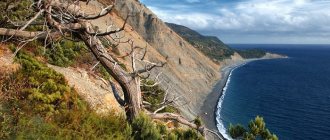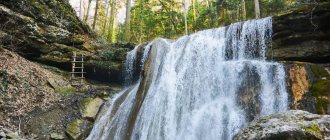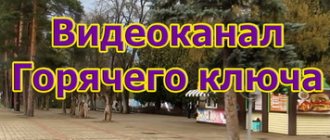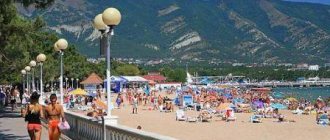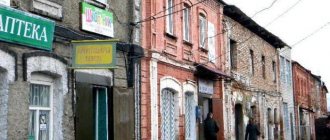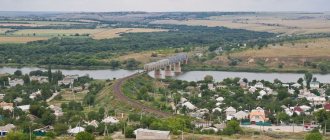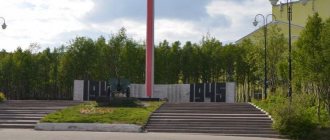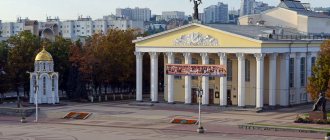Resourceful tourists, when choosing a place to spend their annual vacation or organize an unforgettable summer vacation for their child, do not stop only at choosing a boarding house, camp or sandy coast. Often, preference is given to cities that are rich in history and have a number of attractions in the vicinity. An incredible number of museums, monuments and unique creations of nature are concentrated in Anapa. The Bolshoi Utrish Nature Reserve, located not far from it, is famous for its unsurpassed beauty of landscapes and the most interesting struggle for “survival.”
Utrish Nature Reserve on the map of Russia
The protected area lies within the Anapa urban district and partly within the Novorossiysk municipality. The total area of the two clusters (Abraussky and Sheskharissky) is 9,848 hectares. The size of the Black Sea water area lying across the protective (coastal) strip (2 episodes) is 783 hectares. Geographically, this area occupies that half of the central part of the Abrau Peninsula, which descends to the sea. And also a fragment of the Sheskharis microdistrict.
The organization's office is located in Anapa - at Severnaya, 41B. There is also a central estate (visit center with the Museum of Nature). But all approaches are located in the village. Sukko.
The Utrish State Natural Biosphere Reserve was formed in September 2010. Although they tried to reserve a wonderful piece of the Abrau Peninsula at the end of the last century. The fact is that it is constantly in a dangerous neighborhood with poaching raids and attractions related to oriental and occult practices. In general, the anthropogenic load is strong! But the leaders of the Novorossiysk administration have repeatedly rejected the project. We were worried about a decrease in the tourist flow to the Abrau Peninsula (after all, in fact, its southeastern part is almost the only truly resort area in the named port and factory urban district)... Until March 3, 2011, the specially protected natural area existed without an official Regulation on the reserve . And in subsequent years, eco-trails were developed.
Snake Bay
800 meters north of the village is Zmeinaya Bay, on the site of which there used to be a lake called Zmeiny, because there were many snakes in it. When the narrow isthmus separating the lake from the sea was blown up, a bay was formed.
Juniper forests grow along its banks, the depth of Snake Lake reaches eight meters, and the area is 22 hectares.
In Zmeinaya Bay there is a parking lot for sailing and motor yachts, and everyone can rent a boat and go on a trip to the open sea.
Goals and objectives
The activities of the Utrish Nature Reserve are based on four areas:
- protection of security and closed (for tourists) nickels from any impact;
- further scientific work (identification of new taxa in flora and fauna, etc.);
- state registration (monitoring the number of individuals and plants in the landscape);
- work related to the popularization of the massif itself and the biotope within it...
Relief and climate
The nature of the Utrish Nature Reserve is characterized by phenomena related to its geographical location. A fascinating fragment of the Krasnodar region lies in the dry subtropical belt (in the so-called sub-Mediterranean climate). In winter, the most common temperature mark is +2C. In July it rises to +25C. Precipitation is normal. The maximum occurs from November to February. The minimum is at the end of July and August. Thunderstorms are recorded throughout the year. And in large quantities. Storms come in the last days of August and make themselves felt throughout September. Rarely.
The relief of the protected area is a series of low ridges parallel to each other on a “basic” asymmetrical structure stretched along the Black Sea (the height increases from northwest to southeast). In the northwestern neighborhood of the buffer zone, the GZ is the official beginning of the Caucasus Mountains (the point is not protected, there is a monument there that attracts crowds of vacationers). The formations in question are clearly affected by erosion. The rivers of the Utrish Nature Reserve also diversify the orography of this corner with their wonderful valleys. The steepness of these slopes ranges from ravines of no more than 7 degrees to sheer rocky cliffs with little or no coastal edges. The highest point of the protected area is Mount Orel in the southeast (almost 549 m above sea level).
The soils of the small ridges descending towards the Riviera lie on solid (geological) material. It is composed of flysch (alternating mineralogical layers of different sedimentary origin). Flysch layers dip monoclinally towards the sea. Podzols, podzolized classic brown forest soils, brown and, finally, turf soils have already formed on them. They variegatedly intersect with each other under the complex tectonics of the designated peninsula. However, we note here that brown forest formations are formed exclusively under broad-leaved relict arboretums.
Rivers and lakes of the Utrish nature reserve
There are not many bodies of water in the area. The rivers of the Utrish Nature Reserve are included in this list:
- Vodopadnaya River (Vodopadnaya Shchel);
- 3 tributary streams of the Sukko;
- a spring running down from a hill in front of the village of Maly Utrish (above - “vidovka”);
- Sukko River (northern and northeastern buffer zone):
- Durso River (southern border of the protective territory).
Small “arteries” of the gas zone originate at the very “back” of the Navagirsky ridge and ultimately replenish the waters of the bay, which was formed in ancient times to the south of the peninsula of the same name. As you understand, except for the Vodopadnaya River, which forms a canyon, the rest of the named channels are rather streams. The Sukko River begins its winding path at the Likhterov Gap. Just a kilometer from the dam on the Durso River. It stands and merges into the Black Sea. In the village of Blue Valley. Moreover, the lower reaches of the hydrological object are the streets of the resort of the same name. The river forms a spacious (400-meter) valley for such mountains. The watercourse at the bottom is small. As for streams, at certain times of the year they dry up altogether. The nature of water movement in all “arteries” is quite pronounced rises and falls.
All estuaries and lakes of the Utrish Nature Reserve have different origins. Talk about:
- Snake Lake (man-made into a bay on the northern border line);
- Dry estuary (drying water bowl with an area of just over 3 hectares);
- two estuaries of the First Lagoon (separated from the sea area by only 35 meters);
- mountain water mirror not far from the recreation center “Glade of Miracles” (up the road);
- estuary in Maly Utrish (Black Sea buffer, natural pool under the sanatorium).
Throughout its entire length, the border line runs adjacent to a group of unprotected estuaries.
Description
Unlike other protected areas, Bolshoy Utrish includes not only land territory, but also sea waters. So, out of 5112 hectares of total area, the land area is 2582 hectares, and the sea - 2530 hectares.
On the territory of the village of the same name there is an equipped pebble beach, two kilometers to the south, in the area of the first lagoon, there is a nudist beach, closed by rocks from prying eyes. Nearby is the Zhemchuzhny waterfall, flowing from a mountain river and having a height of about five meters. The waterfall is small and full of water in early spring.
Vacationers in Anapa come here to visit the dolphinarium and a small oceanarium; those who wish can go on a yacht ride on the sea waves, but most of all Bolshoi Utrish attracts tourists with its pristine nature.
Flora and fauna
There are 930 types of vascular flora in total. Mosses – 128 species. And the species of lichens and varieties of mushrooms are still at the counting stage. There are 99 “families” of algae. The woody plants of the Utrish Nature Reserve are hornbeams, downy and sessile oaks, maples, ash trees, Crimean pines and lindens. Next are yew berry, blunt pistachio, bush juniper, honeysuckle (honeysuckle), orchard tree and hornbeam. Please note that the general space is divided into 3 botanical zones according to its composition. Pitsunda pine (this is a more southern relict) already lives on the slope part of Sheskharis. The herbaceous plants of the Utrish Nature Reserve are much more numerous here:
shiblyak;
- dogwood;
- creeping juniper;
- stinking juniper;
- thread-leaved speedwell;
- painted orchis;
- Caucasian peony;
- summer white flower;
- yellow glaucium;
- bee-bearing ophris (the route to the growth zone is through the Utrish nature reserve);
- multileaf onosma;
- Steven's katran;
- underdeveloped limodorum;
- shadow colchicum;
- red pollen head;
- goat's belt petal (rare orchid);
- spiny astragalus;
- varnished tinder fungus;
- Komarov's bell;
- low iris;
- beautiful feather grass;
- fescue.
The birds of the Utrish Nature Reserve are represented by 147 taxa. And these predominate:
- Charadriiformes;
- passerines;
- larks;
- Anseriformes;
- some are falconiformes.
The more “scarce” birds of the Utrish Nature Reserve are all other feathered predators (peregrine falcon, short-eared snake eagle, dwarf eagle, white-tailed eagle, black vulture and vulture). Also Pied Rock Thrush and Woodlark. We are also talking about many waterfowl. Such, for example, as the black-throated loon, mute swan, cranes, herons and all sorts of storks.
There are 44 types of mammals in the carefully protected “kingdom”. There are 8 amphibians (“the highlight” of the object is Nikolsky’s turtle, it will be discussed in another section). There are 14 reptiles. The most common animals of the Utrish Nature Reserve in these places are the white-breasted hedgehog (southern), the Caucasian mole, 4 shrews (among them the Caucasian one), 22 taxa of bats (!) and 30 small rodents. Raccoon raccoon, brown hare, common squirrel, stone and pine martens, fox and badger. Next in number are the wolf, jackal, weasel, raccoon dog and wild boar. Much rarer animals of the Utrish Nature Reserve are represented by roe deer, Caucasian lynx, Caucasian red deer, Caucasian otter and even the Caucasian forest cat.
In protected water areas (sea, river, stream and lake) the following ichthyofauna is:
- bottlenose dolphin (dolphin);
- white lobster (dolphin);
- common porpoise (the latter spends time almost on the shore - the baby whale often frolics at the very edge)
- horse mackerel (its feeding route passes here);
- anchovy;
- mackerel;
- brook trout;
- mullet;
- goby;
- katran (shark);
- carp;
- silver carp.
In total, there are 71 aquatic inhabitants (sea inhabitants) and 4 (lake-river inhabitants). The sea crab is especially interesting for visitors. It is more noticeable in the morning.
Sights of the Utrish Nature Reserve
Museum of Nature at the visitor center in Anapa
As a way to introduce guests to natural resources in absentia, the Utrish Nature Reserve shows them a hall with a very memorable exhibition. The facade of the central estate itself attracts with its architectural “freshness”. Inside there is a huge screen of high-quality photos, a large visual map, a monitor (after all, movies are shown in the room). Several stuffed “signature” birds and mammals.
Snake Lake
The snake lake of the Utrish nature reserve meets us first on the way from Sukko to the Bolshoi Utrish resort. It touches the reservoir with its infrastructure. The mirror has a complex shape and looks more like a bay (the lintel was blown up). The main value of the presented water tract is snakes (it was christened in honor of them). By the way, in ancient times there were hundreds of times more of them. They say that the Caucasian toponym “Utrish” itself is somehow connected with mysterious reptiles (in more ancient times the cape was named Mendeup, but then it was named after the Adyghe “Snake Clan”). Bizarre snags - “ropes”, “sharp” paths between coniferous and deciduous thickets, stones painted by unusual visitors. 17 species of woodlice (for comparison: in the Moscow region 2). From the mountain peaks, the lake water appears unnaturally turquoise. The edge is comfortable. And on a yacht you can!
Pearl Falls
The Utrish Nature Reserve invites you to explore the westernmost waterfall of the Krasnodar Territory. Walk here from the sea for at least 2.5 kilometers (the spillway is in the upper reaches of the Vodopadnaya River). The vividness of the impressions made people perceive the threshold as a “symbol” of the entire reserve. The water begins its journey from Soldatskaya Mountain (along the river you can walk 13 km along a long-established path, and higher up there are “goat” passages). The height of the spillway in the protected cluster is 5.5 meters. The width is insignificant. Previously, naturists washed off the sea salt under this natural “shower”. Now - screw you.
A piece of the bay and the Savina Shchel tract
The Utrish Nature Reserve also has two sectors, including the coast and part of the water area. Both are marked between the branch of the Vodopadnaya water stream and the resort infrastructure at the mouth of the stream, which lies under the observation deck (precisely the one to the north-west of the village of Maly Utrish). They are constantly patrolled by boats of local inspectors. Viewed from land with binoculars. What is Savina Shchel? The conversation turned to a picturesque location, the upper terrace of which eventually turns into River Lane in the village of Sukko (here the gap connects with the valley of the namesake river). And it’s more convenient to get to the tract from a populated area (however, with a group). The section with the beech and hornbeam grove is what the prison staff themselves call “a place of power.”
Canyon Trail
We are talking about a gap leading to Mount Interrupted. Due to frequent landslides and fires, the route is sometimes closed for reconstruction. The most mysterious adventure. The path is still young - the Ministry of Emergency Situations did not allow it to be opened for a long time. The complex of tracts is in the greatest decay. What is striking is that its sides consist of multi-colored rocks, many of which are scree...
What's the best way to get there?
The protected area is located 16 kilometers south of Anapa.
You can get there by sea boat departing daily from Anapa, by private car , by regular bus or by minibus departing from the city to the village of Sukko. But if you came specifically for the purpose of ecotourism and are going to spend more time in the reserve, you can settle in the village itself or in the village of Durso, which is located on the southern border of the reserve.
The price of accommodation in the private sector ranges from 300 to 400 rubles per day per person. By the way, this is a great option for those who prefer a more relaxing holiday. The beaches are clean and well-groomed, and prices in local restaurants, cafes and canteens are more affordable than in the resort of Anapa. The villages have water attractions, so you can ride a boat or a banana boat here too. In addition, there are many dolphins here that swim very close to people.
The beaches of the reserve and the village of Sukko are pebbly, the seabed is sandy.
Rest on the territory of the Utrish nature reserve
“Wild” (independent) forays are allowed only in the buffer (these are the immediate suburbs of Anapa or Novorossiysk - everything north and northeast of the Sukko River, southeast of the Durso River and everything that does not concern limited water areas in the Black Sea region).
All organized routes around the Utrish Nature Reserve are indicated below. It remains to be added that minor citizens travel through them only with adults. There are no wooden decks yet, but viewing platforms with benches have already been built.
"Hiking in the Canyon"
The excursion mentioned in the title is the most dangerous. With elements of serious trekking. First, there is a lengthy briefing. Shoes – sports or hiking. Preschoolers and people with disabilities are not accepted into the group. The route is circular – 2,600 m. With ascent. Review time is several hours.
"Excursion to Savina Shchel"
The landscape area where the Utrish nature reserve is located today is a region where ancient xerophytic forests, sometimes short vines, and Mediterranean woodlands have been preserved to this day. There are also many endangered (including relict) birds and animals. Savina Shchel speaks about this best. The review block will focus attention on this fact. The direction is radial. Distance 1.5 kilometers. The time required will be 2 hours. Seasonality – all year round. Lead no more than 3 groups in one day.
“Sea tour from Bolshoi Utrish to Pearl Falls”
What is the main difference between this tour? It lies in the ability to explore the surroundings directly from the water. The two-hour journey is designed to enjoy several colorful tracts at once, giving rise to exceptionally idyllic memories. 3,400 meters. With stops at interesting recreational areas. There are life jackets.
“Walking along a protected section of the coastline”
Here the Utrish Nature Reserve presents to your attention an eco-trail, which is considered a guiding thread from cordon to cordon. Radial trip with a length of 2,500 meters. Seasonality – May-October. The only voyage where as many as 50 people are taken! The goal is to show vacationers the lifestyle of Nikolsky’s turtle. Its largest population lives on the peninsula - the named reptiles descend here from the southern slopes of the mountains (from juniper woodlands, along narrow stream valleys). They can live even at the highest elevations of Abrau. In addition (as in the sea “promenade” just described), expect a story about the ichthyofauna, algae and plankton of the Black Sea.
“Horse rides along the forest boundaries of the State Reserve
The latest brand of a rich program from the scientific and educational department of the prohibitionist is indicated in the title. We mean the same trips, but in the saddle. The tourist “squadron” is headed by an experienced inspector who is a horse riding instructor.
Recommendations for tourists
- In the Utrish Nature Reserve, travelers visit the protected area through a checkpoint.
- Tourists receive passes at the address indicated (at the beginning of the article). Or online (application is sent by email). Minimum group size is 10, maximum is 30 hours.
- Damage to sold-out signs and other property of an environmental institution is a fine.
- In protected areas, it is prohibited to pick leaves and flowers, collect rocks, mushrooms and berries, frighten turtles, or destroy anthills and bird nests. Make loud noise and smoke. Carving on tree trunks and rocks is also considered vandalism.
- Economic activities are prohibited: grazing, walking, forest cutting, haymaking, dams
- Open fires are not allowed in the main protected area...
You cannot enter the reservation space using your own vehicles. Carrying harmful substances, drugs, weapons, fishing gear and containers.
- Upcoming professional video shooting must be declared.
- Even on “tourist” land, it is prohibited to use soap and shampoos near flowing springs, lakes and waterfalls (household chemicals disrupt the eco-balance).
- Accommodation in the GC will cost vacationers different amounts (the guest complex is not part of the reserve - check the websites). The reserve's services include walking and sea excursions (from 150 to 1,000 rubles). Service related to equestrian adventures is priced according to the negotiated price list. And some eco-trails can become a route for horseback riding (such are not uncommon).
- The cost of numerous branded museum souvenirs starts from 30 rubles.
- Worth knowing: the described reserve is administered by the Bolshoy Utrish reserve. And in 2012, some entrepreneurs attempted to liquidate it.
- The reserve workers inform you: there is a nudist beach (the mouth of the Vodopadnaya River).
The Utrish Nature Reserve is a reservation in which everything is so beautiful that you don’t want to leave here. Hundreds of travelers who have been here write about this. Until 2011, the described “paradise” was protected from visiting “pachkuns” and poachers by local Cossack squads. I must say, they don’t really like nudists. “Additional cavalry” - people who sacredly honor the Orthodox dogmas of the Russian Orthodox Church or Old Believer traditions...
0
Dolphinarium
The Utrish Dolphinarium is the only one on the Black Sea where marine animals perform directly in the Black Sea lagoon; there are also mesh enclosures in which marine animals are kept.
The spectator stands are located in the open air and in the high season there are two to three performances a day, and in the off-season there is one performance each. Bottlenose dolphins, fur seals and a sea lion perform for visitors.
Read more about the dolphinarium >>
